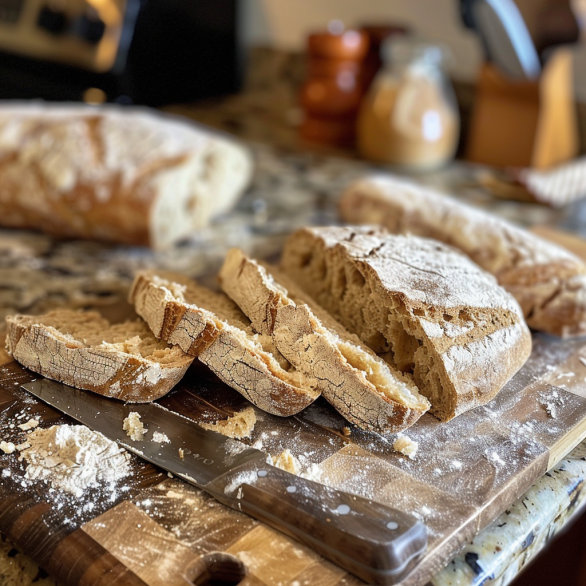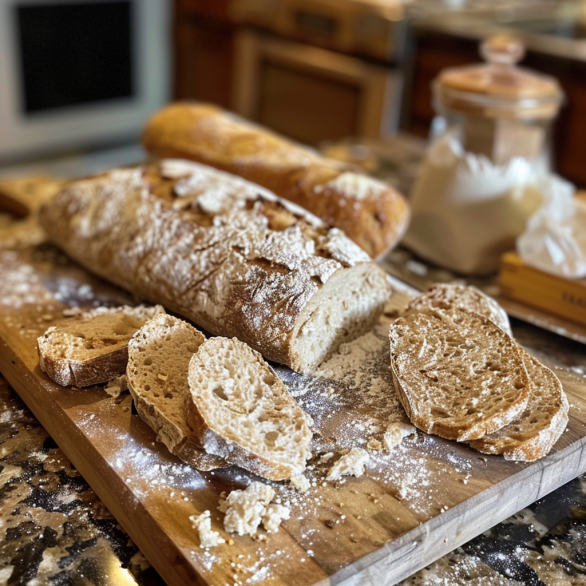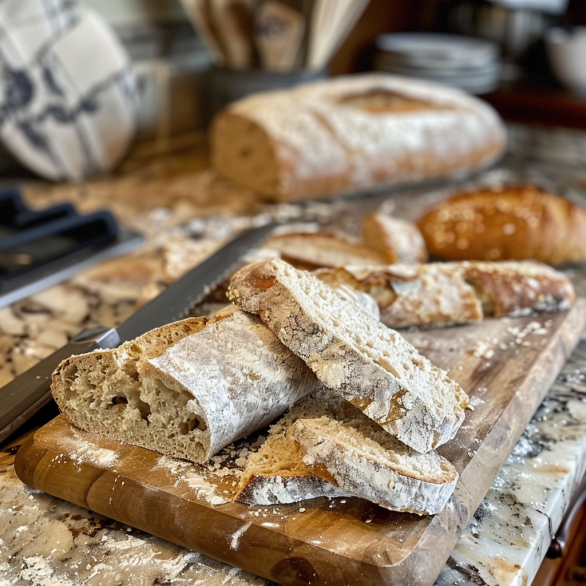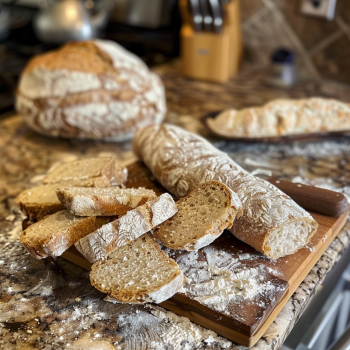All Question You Need
Sheepherders Bread recipe. Originating from the tradition of sheepherders who roamed the rugged landscapes, this hearty bread embodies simplicity, warmth, and sustenance. With a crusty exterior and a soft, chewy interior, this bread is perfect for savoring on its own, pairing with hearty soups, or enjoying as the centerpiece of a wholesome meal. Let the aroma of freshly baked bread fill your kitchen and transport you to a simpler time of nourishing simplicity.
Why You’ll Love It:
- Rich, earthy flavor with a chewy texture that satisfies the soul.
- Simple ingredients and easy preparation make it perfect for beginner bakers.
- Versatile bread that pairs well with both sweet and savory accompaniments.
- Provides a taste of tradition and heritage with every bite.

What is Sheepherder Bread
Sheepherders bread, also known as Dutch oven bread or campfire bread, is a rustic and hearty bread that originated in the American West, particularly among sheepherders who needed simple and durable foods for their outdoor lifestyles. This bread is typically made with basic ingredients like flour, water, yeast, and salt, and it’s often baked in a cast iron Dutch oven over an open fire or in a conventional oven.
The bread has a dense and chewy texture, with a crisp crust and a soft interior. It’s perfect for serving alongside hearty stews, and soups, or as a snack with butter and jam.
Sheepherders bread is cherished for its simplicity and versatility, making it a beloved staple in many households and a nostalgic reminder of the rugged traditions of the American West. It’s often associated with camping trips, outdoor adventures, and gatherings around the campfire, where the aroma of freshly baked bread adds to the ambiance of the wilderness.
What Does Sheepherder Bread Taste Like
Sheepherder’s bread has a rustic and hearty flavor profile, characterized by its dense texture and slightly chewy crumb. The taste is often described as nutty, with subtle hints of wheat and yeast. The crust tends to be crispy and golden brown, adding a satisfying crunch to each bite.
The flavor of sheepherder’s bread can vary slightly depending on the specific recipe and any additional ingredients used, but it generally has a wholesome and comforting taste that pairs well with savory dishes like stews, soups, or grilled meats. Some variations of sheepherder’s bread may incorporate ingredients like whole grains, seeds, or herbs, adding complexity to the flavor profile.
Overall, the Sheepherders Bread recipe is beloved for its simplicity and versatility, making it a timeless classic that evokes memories of hearty meals shared around campfires or family gatherings.
Why is it called sheepherders bread
Sheepherder’s bread is so named because it has historical ties to sheepherders and ranchers in the American West. Sheepherders, who spent long periods of time tending to their flocks in remote areas, needed simple and durable foods that could withstand outdoor conditions and provide sustenance during their work.
This bread became a staple among sheepherders due to its simplicity and ease of preparation. It could be made with basic ingredients like flour, water, yeast, and salt, and it could be baked in a cast iron Dutch oven over an open fire or in a makeshift oven in the field.
Sheepherders Bread recipe was prized for its hearty and satisfying texture, making it a reliable source of energy for those working long hours outdoors. Over time, it became associated with the rugged lifestyle of sheepherders and ranchers in the American West, hence the name “Sheepherder’s Bread.” Today, it remains a nostalgic reminder of this historical tradition and is cherished for its rustic flavor and versatility.

How to Make Sheepherders Bread Recipe
Ingredients:
- 4 cups all-purpose flour
- 1 1/2 cups warm water (about 110°F)
- 2 teaspoons active dry yeast
- 1 tablespoon honey or sugar
- 2 teaspoons salt
- 2 tablespoons olive oil
Instructions:
- In a small bowl, combine the warm water, honey (or sugar), and active dry yeast. Let it sit for about 5-10 minutes, or until the mixture becomes frothy.
- In a large mixing bowl, combine the all-purpose flour and salt. Make a well in the center of the flour mixture.
- Pour the yeast mixture and olive oil into the well of the flour mixture.
- Using a wooden spoon or your hands, gradually incorporate the flour into the wet ingredients until a shaggy dough forms.
- Turn the dough out onto a floured surface and knead it for about 8-10 minutes, or until it becomes smooth and elastic.
- Shape the dough into a ball and place it in a lightly greased bowl. Cover the bowl with a clean kitchen towel or plastic wrap and let the dough rise in a warm, draft-free place for about 1-1.5 hours, or until it doubles in size.
- Preheat your oven to 400°F (200°C). Place a baking stone or baking sheet in the oven to preheat.
- Punch down the risen dough and shape it into a round loaf or an oval loaf, depending on your preference.
- Place the shaped dough onto a piece of parchment paper and let it rise for another 30 minutes, uncovered.
- Once the dough has risen again, carefully transfer it (with the parchment paper) onto the preheated baking stone or baking sheet.
- Bake the bread in the preheated oven for 30-35 minutes, or until it is golden brown and sounds hollow when tapped on the bottom.
- Remove the bread from the oven and let it cool on a wire rack before slicing and serving.
Cooking Tips:
- Ensure that the water used to activate the yeast is not too hot, as it can kill the yeast. Aim for a temperature around 110°F (43°C).
- If you don’t have a baking stone, you can use a baking sheet instead. Place the baking sheet on the middle rack of the oven during preheating.
- For a crustier crust, you can create steam in the oven by placing a small metal pan filled with water on the bottom rack while the bread bakes.
- Experiment with different shapes and sizes for your loaf to create variations in texture and appearance.
- Allow the bread to cool completely before slicing to prevent it from becoming gummy.
Variations:
- Add a handful of chopped fresh herbs, such as rosemary or thyme, to the dough for extra flavor.
- Incorporate a mixture of whole grains, such as oats, barley, or cracked wheat, for added texture and nutrition.
- Sprinkle the top of the shaped dough with coarse salt or seeds, such as sesame seeds or poppy seeds, before baking for extra flavor and visual appeal.
- For a sweeter variation, add a tablespoon of honey or sugar to the dough and include dried fruits, such as raisins or cranberries.
Make It Healthier:
- Substitute whole wheat flour or a combination of whole wheat flour and all-purpose flour for a higher fiber content.
- Reduce the amount of salt in the recipe to lower the sodium content.
- Add nutritious ingredients like flaxseeds, chia seeds, or rolled oats to boost the bread’s nutritional profile.
- Enjoy the bread in moderation as part of a balanced diet, pairing it with lean proteins, fresh vegetables, and healthy fats.
Closing: Savor the timeless taste of tradition with our Sheepherders Bread recipe—a rustic loaf that pays homage to the simple pleasures of life. With its crusty exterior, chewy crumb, and rich flavor, this bread is more than just a recipe—it’s a connection to the past, a celebration of heritage, and a reminder to embrace the nourishing comforts of home. Whether shared with loved ones around the dinner table or savored in solitude with a cup of tea, each slice of Sheepherder’s Bread is a testament to the enduring power of simplicity and sustenance.

Frequently Asked Questions:
Can I use instant yeast instead of active dry yeast?
Yes, you can substitute instant yeast for active dry yeast in this recipe. Use the same amount of instant yeast, but you can skip the step of proofing the yeast in warm water. Simply add the instant yeast directly to the flour mixture and proceed with the recipe as directed.
How should I store leftover bread?
To keep leftover Sheepherder’s Bread fresh, store it in a paper bag or a bread box at room temperature for up to 2-3 days. Avoid storing it in a plastic bag, as this can trap moisture and make the crust soggy. If you have more bread than you can consume within a few days, you can freeze it in an airtight container or resealable plastic bag for up to 2-3 months. Thaw frozen bread at room temperature or reheat it in a preheated oven before serving.
Can I make this bread using a bread machine?
Yes, you can adapt this recipe for a bread machine by adjusting the ingredient quantities and following the manufacturer’s instructions for your specific machine. Simply combine the ingredients in the bread machine pan according to the manufacturer’s recommended order, select the appropriate setting (such as the “basic” or “white bread” setting), and let the bread machine do the rest. Keep in mind that the baking time and temperature may vary depending on your machine.
Can I make this bread without using olive oil?
While olive oil adds flavor and moisture to the bread, you can substitute it with other types of oil, such as vegetable oil, canola oil, or melted butter, if desired. Each oil will impart its own unique flavor profile to the bread, so feel free to choose based on your taste preferences.
Can I make smaller loaves or rolls with this recipe?
Yes, you can divide the dough into smaller portions to make individual-sized loaves or rolls instead of one large loaf. Adjust the baking time accordingly, as smaller loaves or rolls will bake faster than a single large loaf. Keep an eye on them to prevent over-browning, and use the same visual and auditory cues (golden brown color, hollow sound when tapped) to determine when they are done baking.
Can I knead the dough using a stand mixer with a dough hook attachment?
Yes, you can use a stand mixer fitted with a dough hook attachment to knead the dough for Sheepherder’s Bread. Simply combine the ingredients in the mixing bowl of the stand mixer and mix on low speed until a shaggy dough forms. Then, increase the speed to medium-low and knead the dough for 8-10 minutes, or until it becomes smooth and elastic. You may need to stop the mixer occasionally to scrape down the sides of the bowl and ensure even mixing.
Can I add cheese or other savory ingredients to the dough?
Yes, you can customize this bread recipe by adding shredded cheese, chopped herbs, minced garlic, or other savory ingredients to the dough for additional flavor. Fold these ingredients into the dough during the kneading process, ensuring that they are evenly distributed throughout the dough. Keep in mind that extra ingredients may affect the texture and rise of the bread, so you may need to adjust the amount of flour or liquid accordingly.
Can I make this bread using a no-knead method?
While traditional Sheepherders Bread Recipe requires kneading to develop gluten and achieve the desired texture, you can experiment with a no-knead method if you prefer. Simply mix the ingredients together in a bowl until a shaggy dough forms, cover the bowl with plastic wrap, and let it rise at room temperature for 12-18 hours. Then, shape the risen dough into a loaf, let it rise again for 30 minutes, and bake it as directed. Keep in mind that the texture and crumb of the bread may be slightly different compared to the traditional kneaded version, but it will still be delicious and flavorful.
You Might Be Interested In
- Best Hot Fudge Brownie Bread Recipe
- Make Easy Kamut Bread Recipe
- Ina Garten Banana Bread Recipe
- Easy Homemade Focaccia Bread Recipe
- Make Easy Cheesy Garlic Bread Recipe
- Best Coffee Walnut Pumpkin Bread Recipe

